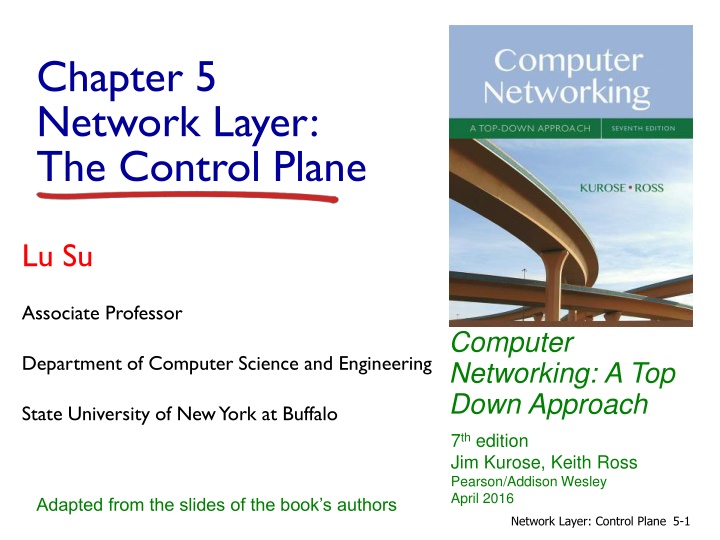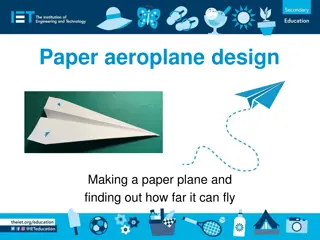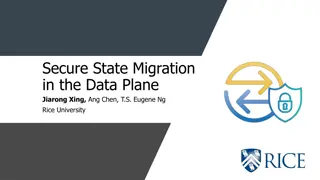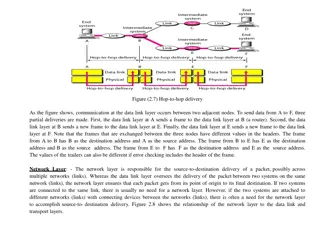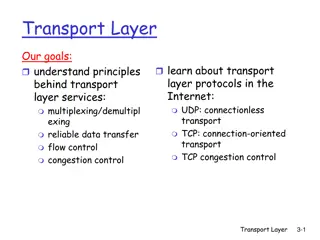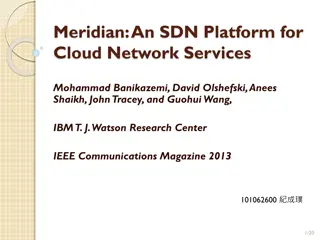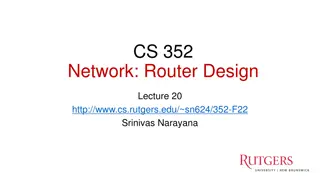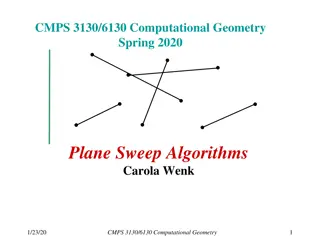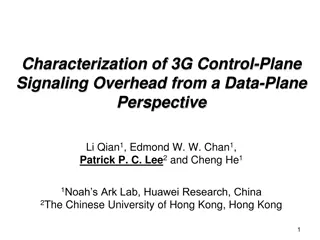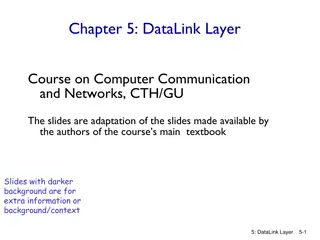Network Layer Control Plane Overview
The network layer control plane encompasses routing protocols, scalability challenges, intra-AS and inter-AS routing, and interconnected autonomous systems in the context of Internet routing. Explore how routers exchange routing information, handle billions of destinations, and route packets across multiple domains efficiently.
Download Presentation

Please find below an Image/Link to download the presentation.
The content on the website is provided AS IS for your information and personal use only. It may not be sold, licensed, or shared on other websites without obtaining consent from the author.If you encounter any issues during the download, it is possible that the publisher has removed the file from their server.
You are allowed to download the files provided on this website for personal or commercial use, subject to the condition that they are used lawfully. All files are the property of their respective owners.
The content on the website is provided AS IS for your information and personal use only. It may not be sold, licensed, or shared on other websites without obtaining consent from the author.
E N D
Presentation Transcript
Chapter 5 Network Layer: The Control Plane Lu Su Associate Professor Computer Networking: A Top Down Approach Department of Computer Science and Engineering State University of New York at Buffalo 7th edition Jim Kurose, Keith Ross Pearson/Addison Wesley April 2016 Adapted from the slides of the book s authors Network Layer: Control Plane 5-1
Chapter 5: outline 5.1 introduction 5.2 routing protocols link state distance vector 5.3 intra-AS routing in the Internet: OSPF 5.4 routing among the ISPs: BGP 5.5 The SDN control plane 5.6 ICMP: The Internet Control Message Protocol 5.7 Network management and SNMP Network Layer: Control Plane 5-2
Making routing scalable our routing study thus far - idealized all routers identical network flat not true in practice scale: with billions of destinations: can t store all destinations in routing tables! routing table exchange would swamp links! administrative autonomy internet = network of networks each network admin may want to control routing in its own network Network Layer: Control Plane 5-3
Internet approach to scalable routing aggregate routers into regions known as autonomous systems (AS) (a.k.a. domains ) intra-AS routing routing among hosts, routers in same AS ( network ) all routers in AS must run same intra-domain protocol routers in different AS can run different intra-domain routing protocol gateway router: at edge of its own AS, has link(s) to router(s) in other AS es inter-AS routing routing among AS es gateways perform inter- domain routing (as well as intra-domain routing) Network Layer: Control Plane 5-4
Interconnected ASes 3c 3a 2c 3b 2a AS3 2b 1c AS2 1a 1b AS1 forwarding table configured by both intra- and inter-AS routing algorithm intra-AS routing determine entries for destinations within AS inter-AS & intra-AS determine entries for external destinations 1d Intra-AS Routing algorithm Inter-AS Routing algorithm Forwarding table Network Layer: Control Plane 5-5
Inter-AS tasks suppose router in AS1 receives datagram destined outside of AS1: router should forward packet to gateway router, but which one? AS1 must: 1. learn which dests are reachable through AS2, which through AS3 2. propagate this reachability info to all routers in AS1 job of inter-AS routing! 3c 3a 3b 2c AS3 other networks 1c 2a 2b other networks 1a 1b AS2 1d AS1 Network Layer: Control Plane 5-6
Example: setting forwarding table in router 1d suppose AS1 learns (via inter-AS protocol) that subnet x reachable via AS3 (gateway 1c), but not via AS2 inter-AS protocol propagates reachability info to all internal routers router 1d determines from intra-AS routing info that its interface I is on the least cost path to 1c installs forwarding table entry (x,I) x 3c 3a 3b 2c AS3 other networks 1c 2a 2b other networks 1a 1b AS2 1d AS1 4-7 Network Layer
Example: choosing among multiple ASes now suppose AS1 learns from inter-AS protocol that subnet x is reachable from AS3 and from AS2. to configure forwarding table, router 1d must determine which gateway it should forward packets towards for dest x this is also job of inter-AS routing protocol! x 3c 3a 3b 2c AS3 other networks 1c 2a 2b other networks 1a 1b AS2 1d AS1 ? 4-8 Network Layer
Example: choosing among multiple ASes now suppose AS1 learns from inter-AS protocol that subnet x is reachable from AS3 and from AS2. to configure forwarding table, router 1d must determine towards which gateway it should forward packets for dest x this is also job of inter-AS routing protocol! hot potato routing: send packet towards closest of two routers. determine from forwarding table the interface I that leads to least-cost gateway. Enter (x,I) in forwarding table use routing info from intra-AS protocol to determine costs of least-cost paths to each of the gateways learn from inter-AS protocol that subnet x is reachable via multiple gateways hot potato routing: choose the gateway that has the smallest least cost 4-9 Network Layer
Intra-AS Routing also known as interior gateway protocols (IGP) most common intra-AS routing protocols: RIP: Routing Information Protocol OSPF: Open Shortest Path First (IS-IS protocol essentially same as OSPF) IGRP: Interior Gateway Routing Protocol (Cisco proprietary for decades, until 2016) Network Layer: Control Plane 5-10
RIP ( Routing Information Protocol) included in BSD-UNIX distribution in 1982 distance vector algorithm distance metric: # hops (max = 15 hops), each link has cost 1 DVs exchanged with neighbors every 30 sec in response message (aka advertisement) each advertisement: list of up to 25 destination subnets (in IP addressing sense) from router A to destination subnets: subnet hops u 1 v 2 w 2 x 3 y 3 z 2 u v w A B x C D z y Network Layer 4-11
RIP: example z y w x B D A C routing table in router D destination subnet w y z x . next router # hops to dest A B B -- . 2 2 7 1 .... 4-12 Network Layer
RIP: example A-to-D advertisement dest next hops w x z . - 1 - 1 C 4 ... z y w x B D A C routing table in router D destination subnet w y z x . next router # hops to dest A B B -- . 2 2 7 1 .... 5 A 4-13 Network Layer
RIP: link failure, recovery if no advertisement heard after 180 sec --> neighbor/link declared dead routes via neighbor invalidated new advertisements sent to neighbors neighbors in turn send out new advertisements (if tables changed) link failure info quickly (?) propagates to entire net poison reverse used to prevent ping-pong loops (infinite distance = 16 hops) 4-14 Network Layer
RIP table processing RIP routing tables managed by application-level process called route-d (daemon) advertisements sent in UDP packets, periodically repeated routed routed transport (UDP) transprt (UDP) network forwarding (IP) table network (IP) forwarding table link link physical physical 4-15 Network Layer
OSPF (Open Shortest Path First) open : publicly available uses link-state algorithm link state packet dissemination topology map at each node route computation using Dijkstra s algorithm router floods OSPF link-state advertisements to all other routers in entire AS carried in OSPF messages directly over IP (rather than TCP or UDP link state: for each attached link IS-IS routing protocol: nearly identical to OSPF Network Layer: Control Plane 5-16
OSPF advanced features security: all OSPF messages authenticated (to prevent malicious intrusion) multiple same-cost paths allowed (only one path in RIP) for each link, multiple cost metrics for different TOS (e.g., satellite link cost set low for best effort ToS; high for real-time ToS) integrated uni- and multi-cast support: Multicast OSPF (MOSPF) uses same topology data base as OSPF hierarchical OSPF in large domains. Network Layer: Control Plane 5-17
Hierarchical OSPF boundary router backbone router backbone area border routers area 3 internal routers area 1 area 2 Network Layer: Control Plane 5-18
Hierarchical OSPF two-level hierarchy: local area, backbone. link-state advertisements only in area each nodes has detailed area topology; only know direction (shortest path) to nets in other areas. area border routers: summarize distances to nets in own area, advertise to other Area Border routers. backbone routers: run OSPF routing limited to backbone. boundary routers: connect to other AS es. Network Layer: Control Plane 5-19
